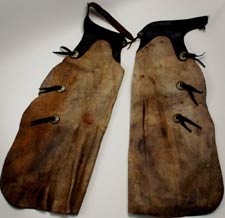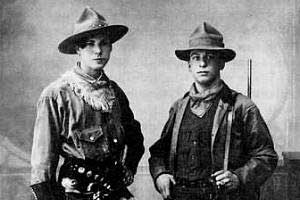
Chaps, which are cowboy leggings, were correctly pronounced “shaps”. They’re short for chaparejos (shap-ar-EH-hos), which were another important cowboy tool.
Chaps are intended to protect the legs of cowboys from contact with daily environmental hazards experienced in working with cattle, horses and other livestock. They help to protect the riders’ legs from injury when riding through brushy terrain that included sagebrush, cacti thorns, mesquite and other thorny vegetation.
Consisting of leggings and an integrated belt, they are buckled on over trousers but have no seat and are not joined at the crotch. In the early days, they were primarily made of smooth leather or suede.
Early History
The earliest form of protective leather garment was used by mounted riders who herded cattle in Spain and Mexico and were called armas, which meant “shield.” Back then, they were essentially two large pieces of cowhide that were used more as a protective apron attached to the horn of the rider’s stock saddle. The pieces were spread across both the horse’s chest and the rider’s legs.
From this early and rather cumbersome design came modifications that placed the garment entirely on the rider, and then style variations were adapted as the trend moved northward into the pacific coast and northern Rockies of what today is the United States and Canada. Certain design features may also have descended from Mountain men who copied the leggings worn by Native Americans.
Different styles developed to fit the local climate, terrain and hazards of each locality. Later, designs were modified for purely stylistic and decorative purposes. By the late 1870s, most Texas cowboys wore them as the cattle industry moved north.
Uses
Chaps are also used in a variety of equestrian disciplines. In the modern world, they are worn for both practical work purposes (cattle ranching, rodeo events and school horses) and exhibitions. Leather chaps stick to a leather saddle or a bareback horse better than do fabric trousers and thus help the rider stay on.
Popular Styles of Chaps
 Shotgun Chaps: Also called “Stovepipes” because the legs are straight and narrow. In wide use by the late 1870a, they were the earliest design used by Texas cowboys. They feature a snug fit, wrapping completely around the leg and held tight with a full-length zipper running along the outside of the leg from the thigh to just above the ankle. The edge of each legging is usually cut with a slight flare to allow a smooth fit over the arch of a boot. Their tight design was better at trapping body heat, an advantage in windy, snowy or cold conditions. Obviously not so pleasant in very hot or humid weather. Shotgun chaps are more common on ranches in the northwest, Rocky Mountains and northern plains states, as well as Canada. This design is the most common in western horse show competition
Shotgun Chaps: Also called “Stovepipes” because the legs are straight and narrow. In wide use by the late 1870a, they were the earliest design used by Texas cowboys. They feature a snug fit, wrapping completely around the leg and held tight with a full-length zipper running along the outside of the leg from the thigh to just above the ankle. The edge of each legging is usually cut with a slight flare to allow a smooth fit over the arch of a boot. Their tight design was better at trapping body heat, an advantage in windy, snowy or cold conditions. Obviously not so pleasant in very hot or humid weather. Shotgun chaps are more common on ranches in the northwest, Rocky Mountains and northern plains states, as well as Canada. This design is the most common in western horse show competition
Batwing chaps: These are cut wide with a flare at the bottom and are usually made of smooth leather with only two or three fasteners around the thigh. They allow for greater freedom of movement for the lower leg and for easier mounting of a horse. With more air circulation, this design was somewhat cooler for hot weather wear. Batwing chaps are often seen on rodeo riders and on working ranches, particularly in Texas. They were a later design, developed after the end of the open range.
Woolies: (pictured above right) These chaps are a variation on shotgun chaps, made with a fleece or hair-on hide, often angora wool, lined with canvas on the inside. Woolies are the warmest chaps and are associated with the northern plains and Rocky Mountains. They appeared on the Great Plains somewhere around 1887.





